

Analysis of the size distribution on the nanoparticles released into the air as airborne nanoparticles can be obtained by the EN 17199-4 small rotating drum methodology in which an electronic impactor and a nanoparticle counter are being used. The DLS particle size analysis in the liquid phase provides information on the hydrodynamic particle size of the nanoparticles. It provides a high-throughput and fully-repeatable measurement methodology for isolated exosome particles in solution, providing confirmation of their particle size and concentration. Nanoparticles down to 3 nanometers can be identified and measured. Dynamic light scattering is at the forefront of exosome research and characterization for diagnostic and therapeutic applications. The corresponding DLS particle size distribution was acquired ×10 times without pause. The upper limit of the technique is in the size range of approximately 10 micrometers and the strong focus of dynamic light scattering is clearly on the nanoparticle size range. dynamic light scattering (DLS) (see below for DLS protocol). The measurement range of the dynamic light scattering technique is therefore also limited on the upper range since larger particles are simply to heavy to display Brownian motion and will also settle too fast. In principle, the DLS measurements can be performed with the detector positioned at any angle. The faster movement of the smaller particles is due to the energy transfer of liquid molecules to the solid particles and nanoparticles will experience a greater effect of this energy transfer than larger and heavier particles. Dynamic light scattering provides insight into the dynamic properties of soft materials by measuring single scattering events, meaning that each detected photon has been scattered by the sample exactly once. The Brownian motion of particles in the liquid phase occurs randomly in every direction and smaller particles will typically travel faster than larger particles. These technologies use the theory of Brownian motion by analyzing the random changes of light intensity scattered by particles in solution. This protocol provides step-by-step instructions for preforming a basic DLS experiment assuming you have been trained on the instrument by Dr.Erbse or. The technique uses a laser to track the Brownian motion of particles and in particular nanoparticles. Dynamic light scattering (DLS) and nanoparticle tracking analysis (NTA) are two orthogonal and complementary methods of measuring size of particles in a sample. Every point is illustrated by case studies, including a commercially available albumin, a small RNA virus isolated from plants, as well as four soluble proteins and a ribonucleoprotein assembly purified and characterized by students in the frame of their master degree.Analysis of the nanoparticle size distribution and nanoparticles identification can be obtained by means of Dynamic Light Scattering (DLS), sometimes also referred to as Photon Correlation Spectroscopy. The Biophysical Resource at Keck Facility offers the Dynamic Light Scattering Detector (DynaPro, Wyatt Technology - formerly Protein Solutions) as an 'open access' instrument that can be used by trained users. Variables like temperature, solvent viscosity, and inter-particle interactions may also influence particle size determination. To ensure reproducible quantitative data, attention should be paid to controlling the preparation and handling of proteins or assemblies because variations in the state of aggregation, induced by minor changes in experimental condition or technique, might compromise DLS results and affect protein activity. It reviews the basic concepts of light scattering measurements and addresses four critical aspects of the analysis and interpretation of DLS results. This article is written for graduate and undergraduate students with access to DLS and for faculty members who wish to incorporate DLS into a lab activity, a practical course or research. Dynamic light scattering (DLS) analyses are routinely used in biology laboratories to detect aggregates in macromolecular solutions, to determine the size of proteins, nucleic acids, and complexes or to monitor the binding of ligands.


 0 kommentar(er)
0 kommentar(er)
